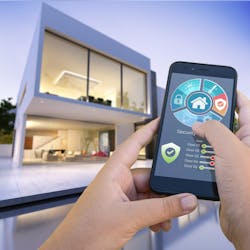This article originally appeared in the August 2023 issue of Security Business magazine. When sharing, don’t forget to mention Security Business magazine on LinkedIn and @SecBusinessMag on Twitter.
Manufactured lighting enables our ability to see, read, and navigate when natural light is inadequate, but that is not all it affects. “The Power of Light floods through our lives on a daily basis. It is present in so many forms and is arguably the most influential force on how we perceive and connect with the world around us,” explained Sally Augustin, Ph.D, in the June 2021 issue of Psychology Today. “We live, communicate, and celebrate in all of its mediums. Light has the power to give life and save life. It plays with our emotions and considerably affects the way we feel.
Lighting typically represents about 15% of a home’s utility bills. Ways to save energy such as sensors to detect when people are in a room or outdoor lights that turn on and off as light changes have been available since the 1980s, but ever-better savings techniques are available with smart lighting, and residential security integrators should be taking advantage.
In addition to saving energy, remote control adds a convenience benefit to lighting. Turning off a stray light without leaving the chair or a bedroom light without getting up are small conveniences valued by consumers. Lighting a dark hallway at night aids safety. The ability to control lights remotely has been available since the late 70s using X-10 technology. But smart lighting via wireless networks is more easily accessible for most buyers.
Finally, more sophisticated scene lighting, programmed to reflect moods or activities bring even more convenience and mood impact.
Slow and Steady Growth
According to Parks Associates’ latest research study, Smart Lighting Market Assessment, smart lighting product demand softened in 2022, following general spending and home renovation trends. Smart lighting products have enjoyed years of slow-and-steady growth, with peak buying during the COVID-19 pandemic. As with other smart home products, demand has since softened as consumers leave the house to get back to work, and high inflation tempers spending.
Adoption and intention rates are now in line with pre-pandemic norms. Parks Associates research shows 13% of U.S. internet households have at least one smart light bulb, and 8% own a smart plug/power strip. Smart lighting remains among the most popular smart home products, but lighting manufacturers and retailers should adjust their forecasts to reflect the current macro-economic environment.
Companies serving the residential market are paying closer attention to the new features that are drawing in consumers. Vivint, for example, recently announced expansion into smart lighting with the addition of smart switches and bulbs. This new offer is unique in that the solution enables homeowners to avoid rewiring switches by attaching the smart switch over an existing light switch. Then, the switch is wirelessly paired to the bulb.
Interoperability Matters
Parks Associates research also finds that the top concern for smart lighting consumers – as is the case for many smart home device users – is interoperability. Demand for all smart lighting device features has increased over the past three years, but desire for smart lighting products to work with other smart home devices owned has increased substantially.
Smart lighting OEMs heavily emphasize their products’ ability to work with other devices to create scenes and routines for entertainment, safety, and convenience use-cases. That said, most smart lighting products are acquired stand-alone at retail and not as part of a curated system. Fragmentation in the smart home ecosystem limits users’ ability to enjoy promised benefits.
Manufacturers and solution providers have been challenged in moving towards providing a unified experience, often using proprietary protocols that serve their own device or solution needs but do not always serve the greater needs of an end-to-end unified smart home experience.
Major industry brands, including Amazon, Apple, Google, and Samsung have aligned behind Matter, an IP-based connectivity protocol championed by the Connectivity Standards Alliance. The intention of the standard is to unify smart home devices into a single application framework. To developers and manufacturers, the standard will make it easy to create products that work with a variety of ecosystems. To consumers, the Matter symbol will provide assurance that smart devices work reliably together.
In 2023, Matter remains embryonic. A few lighting leaders, such as Philips Hue and Belkin, have slowed down or backed out for now. There are, however, several smart lighting products on market as of June 2023 that incorporate Matter, including smart lighting products from Nanoleaf and Yeelight, and smart plugs from Eve and TP-Link.
This initiative will define the industry for years to come and may be the most important driver for mass adoption of connected devices in the home. That said, full deployment will take years, and brand-to-brand integrations through APIs and other initiatives continue.
Curated systems also remain a key avenue to an integrated experience and important channel for smart lighting solutions. For example, in Q1 2023, both Hubbell iDevices and Jasco announced that their smart lighting solutions now integrate with the Alarm.com residential security platform.
The smart lighting market is just getting ignited, and we will continue to see existing players expand into this area as well as new players enter the market. In addition, with energy providers and utilities looking to conserve energy in homes, this is a key category to watch.
Defining Smart Lighting
Parks Associates defines the following key product categories in the smart lighting segment:
• A smart light bulb is a wirelessly connected, energy efficient LED light bulb that can be remotely controlled, scheduled, or triggered by other smart devices. Some smart lightbulbs are dimmable, and some can shift colors among shades of white or the whole color spectrum.
• A smart in-wall switch replaces a traditional in-wall light switch with one that is connected to the internet wirelessly and can be remotely controlled, scheduled, or triggered by other devices.
• A smart plug is a portable device that plugs into a wall outlet and wirelessly connects to the internet. A smart plug can be used to remotely control or schedule any appliance, lamp, or electronic device that is plugged into it. Some smart plugs can measure energy usage and detect appliance faults or fire risks.
About the Author

Jennifer Kent
Jennifer Kent is Senior Vice President and Principal Analyst for research firm Parks Associates. www.parksassociates.com

